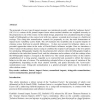Free Online Productivity Tools
i2Speak
i2Symbol
i2OCR
iTex2Img
iWeb2Print
iWeb2Shot
i2Type
iPdf2Split
iPdf2Merge
i2Bopomofo
i2Arabic
i2Style
i2Image
i2PDF
iLatex2Rtf
Sci2ools
JOI
2010
2010
Citing-side normalization of journal impact: A robust variant of the Audience Factor
The principle of a new type of impact measure was introduced recently, called the "audience factor" (AF). It is a variant of the journal impact factor where emitted citations are weighted inversely to the propensity to cite of the source. In the initial design, propensity was calculated using the average length of bibliography at the source level with two options: a journal-level average or a field-level average. This citing-side normalization controls for propensity to cite, the main determinant of impact factor variability across fields. The AF maintains the variability due to exports-imports of citations across field and to growth differences. It does not account for influence chains, as in powerful approaches taken in the wake of Pinski-Narin's influence weights. Here we introduce a robust variant of the audience factor, trying to combine the respective advantages of the two options for calculating bibliography lengths: the classification-free scheme when the biblio...
| Added | 28 Jan 2011 |
| Updated | 28 Jan 2011 |
| Type | Journal |
| Year | 2010 |
| Where | JOI |
| Authors | Michel Zitt |
Comments (0)

